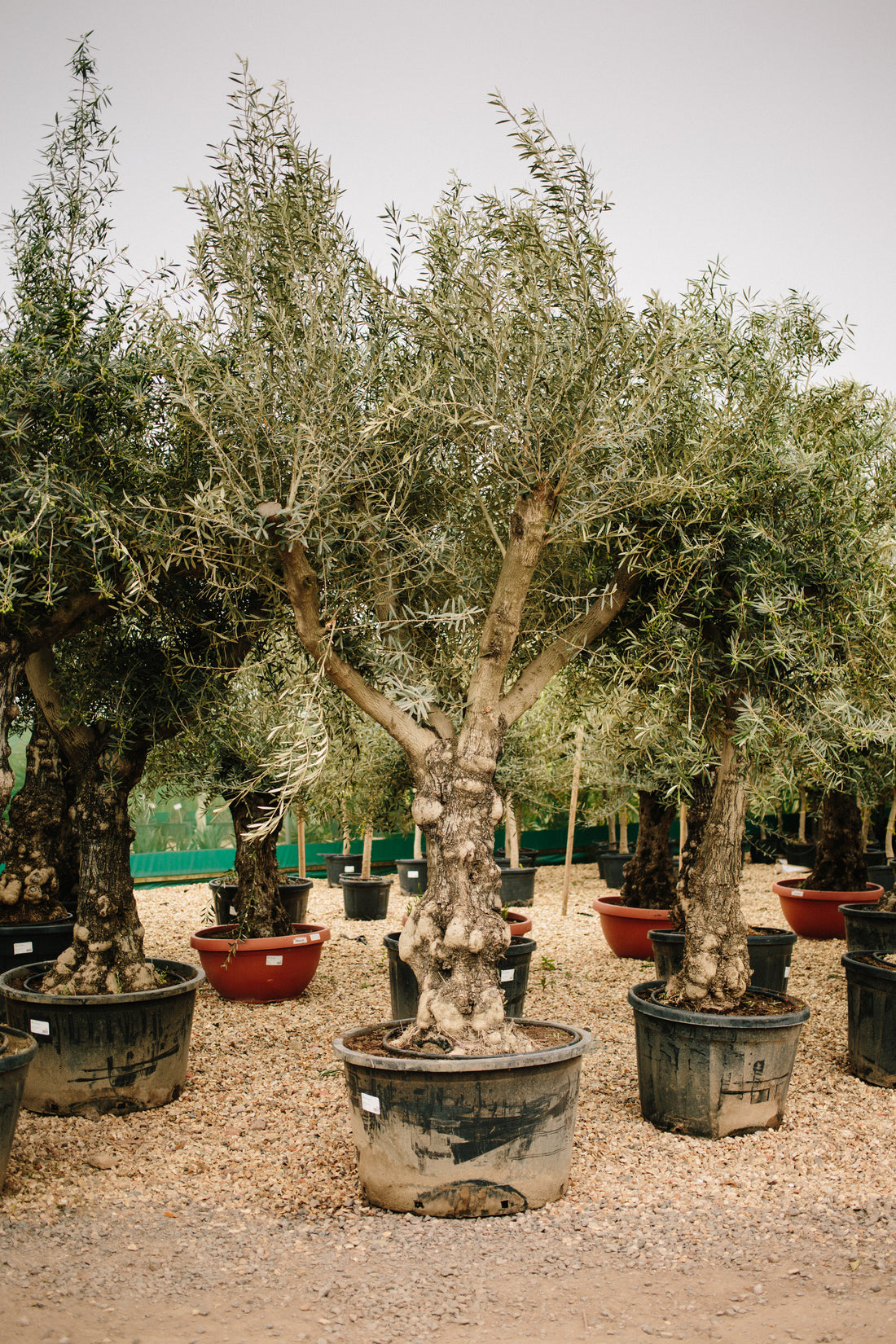Comprehensive Guide to Olive Trees in the UK 2024
Introduction to Olive Tree Cultivation
Let's explore the fascinating world of olive tree cultivation! These remarkable trees have a rich history, originating from the sunny Mediterranean region. They've been cherished for centuries, not only for their delicious fruits but also for their symbolism of peace, wisdom, and prosperity. Delving into olive tree cultivation is not just about agriculture; it's about embracing tradition and stewardship of the land.
Olive trees are incredibly resilient and adaptable. They thrive in a variety of climates, from the rocky terrains of Greece to the arid landscapes of California. So, if you're considering growing olives, you're embarking on an exciting journey that connects you with centuries of heritage and environmental stewardship.
Choosing the Right Olive Tree Varieties
Selecting the perfect olive tree variety is key to a successful orchard. With a wide array of cultivars available, each offering unique flavors and characteristics, it's essential to choose wisely. From delicate and fruity to robust and peppery, there's a variety to suit every palate and purpose.
Consider the Arbequina, renowned for its mild, buttery flavor and early fruiting. Or perhaps the Koroneiki, prized for its high oil content and resilience to pests. And let's not forget about the versatile Frantoio, ideal for both table olives and oil production. By carefully selecting the right variety, you're setting the stage for a thriving orchard and a bountiful harvest.
Preparing the Soil for Planting
Creating the perfect environment for your olive trees starts with the soil. Before planting, it's essential to ensure the soil is well-prepared and nutrient-rich. Olive trees thrive in well-drained soil with a slightly alkaline pH, typically ranging from 6.0 to 7.5.
Soil preparation involves assessing the land, conducting soil tests to determine nutrient levels and pH, and making any necessary amendments. Incorporating organic matter, such as compost or aged manure, can improve soil structure and fertility. Additionally, adjusting the pH with lime or sulfur ensures optimal conditions for root development and nutrient uptake. By investing time in soil preparation, you're laying the groundwork for healthy, productive olive trees.
Planting Olive Trees
Let's dive into the exciting process of planting olive trees! Timing and technique are crucial for ensuring the success of your orchard. It's best to plant olive trees in late winter or early spring, avoiding frost periods. When it comes to spacing, give your trees plenty of room to spread their roots—about 15 feet apart is ideal.
Digging the perfect hole is the first step. Make sure it's twice as wide and deep as the tree's root ball, allowing for ample space for root growth. Backfill the hole with amended soil, ensuring it's well-drained and nutrient-rich. With proper planting techniques, you're laying the foundation for healthy, thriving olive trees.
Watering Olive Trees
Keeping your olive trees hydrated is essential for their growth and development. Established trees require regular watering, especially during dry periods. However, it's crucial not to overwater—olive trees prefer deep, infrequent watering to encourage deep root growth.
Consider installing drip irrigation systems to ensure consistent moisture levels and efficient water use. By providing your olive trees with the right amount of water, you're promoting healthy root development and ensuring a bountiful harvest.
Fertilizing Olive Trees
Proper nutrition is key to the success of your olive orchard. Olive trees have specific nutrient requirements, and fertilizing is essential to meet their needs. Apply organic compost or well-balanced synthetic fertilizers in early spring and late summer to promote growth and fruit production.
Monitor nutrient levels and adjust fertilization practices accordingly to avoid deficiencies or excesses. With the right balance of nutrients, your olive trees will thrive and reward you with a plentiful harvest of delicious fruits.
Pruning Olive Trees
Pruning olive trees is both an art and a science. It's essential for shaping the tree, promoting airflow, and removing dead or diseased branches. Start by pruning young trees to establish a strong framework, focusing on creating an open canopy to allow sunlight to penetrate.
For mature trees, annual pruning is necessary to maintain productivity and health. Remove any crossing or crowded branches, as well as any dead or diseased wood. Avoid excessive pruning, as it can reduce fruit production. With proper pruning techniques, you'll ensure that your olive trees are productive and healthy for years to come.
Protecting Olive Trees from Pests
Olive trees are susceptible to various pests, including olive fruit flies, scale insects, and aphids. Regular monitoring is essential to detect pest infestations early. Employ integrated pest management strategies, such as introducing beneficial insects and using traps, to control pests effectively.
Consider using organic pesticides as a last resort, following label instructions carefully to minimize environmental impact. By staying vigilant and implementing proactive pest management practices, you can protect your olive trees and ensure a successful harvest.
Disease Management in Olive Trees
Several diseases can affect olive trees, including olive knot, verticillium wilt, and olive leaf spot. Preventive measures are crucial for minimizing the risk of disease. Practice proper sanitation by removing and disposing of infected plant material promptly.
Implement cultural practices, such as proper irrigation and pruning, to create an environment that discourages disease development. If necessary, apply fungicides or bactericides according to label instructions. By taking proactive steps to manage diseases, you can protect the health and vitality of your olive trees.
Harvesting Olives
Harvesting olives is a rewarding culmination of your efforts as a grower. Timing is critical—olives should be harvested when they reach optimal ripeness, typically in the fall. Handpicking is the preferred method for table olives, ensuring careful selection and minimal bruising.
For olive oil production, mechanical shaking or harvesting machines can be used to efficiently harvest large quantities of olives. Prompt processing is essential to preserve the quality of the fruit and maximize oil yield. With careful timing and proper harvesting techniques, you'll enjoy the fruits of your labor in the form of delicious olives and flavorful olive oil.
Processing Olives
Once harvested, olives require processing to transform them into culinary delights. For table olives, curing is the traditional method used to reduce bitterness and enhance flavor. Common curing methods include brine curing, dry curing, and lye curing, each imparting its unique taste profile.
For olive oil production, olives undergo a different process. They are crushed to release the oil, which is then separated from the solids and water. This raw olive oil may undergo further processing, such as filtering and refining, to produce the finished product. With careful processing, you'll unlock the full potential of your olives, whether destined for the table or the press.
Storing Olive Products
Proper storage is essential for maintaining the quality and freshness of olive products. Cured olives can be stored in brine or olive oil to preserve their flavor and texture. Ensure containers are airtight and stored in a cool, dark place to prevent spoilage.
Olive oil, in particular, is sensitive to light, heat, and oxygen. Store olive oil in dark-colored, opaque bottles in a cool, dark pantry or cupboard. Avoid storing olive oil near heat sources or in direct sunlight, as exposure to light and heat can degrade its quality over time. By storing olive products properly, you'll prolong their shelf life and enjoy their goodness for longer.
Olive Tree Care Throughout the Seasons
Caring for olive trees is a year-round endeavor, with tasks varying depending on the season. In spring, focus on fertilization and pruning to encourage growth and shape the tree. Summer calls for irrigation and pest management to ensure trees stay healthy and productive.
As temperatures cool in the fall, prepare for harvest by monitoring fruit ripeness and planning for processing. Winter is a time for rest and maintenance, with minimal pruning and protection from frost in colder climates. By adapting your care routine to the seasons, you'll keep your olive trees happy and thriving year after year.
Benefits of Growing Olive Trees
Beyond their delicious fruits and oil, olive trees offer numerous benefits. They contribute to soil stability, preventing erosion and promoting biodiversity. Additionally, they sequester carbon dioxide, helping mitigate climate change.
Olive products are also packed with health benefits, thanks to their high antioxidant content and healthy fats. Regular consumption of olives and olive oil has been linked to reduced risk of heart disease and improved overall health. By growing olive trees, you're not just cultivating food; you're nurturing the environment and your well-being.
Frequently Asked Questions
- Can I grow olive trees in pots?
- Yes, olive trees can be grown in pots, especially dwarf varieties. Ensure the pot is large enough for root growth and provide adequate sunlight and drainage.
- How long does it take for olive trees to bear fruit?
- Olive trees typically start producing fruit within 3 to 5 years of planting, with full production achieved at around 8 to 12 years.
- Do olive trees require pollination to produce fruit?
- While some olive varieties are self-pollinating, cross-pollination can increase fruit set and yield.
- What is the best climate for growing olive trees?
- Olive trees thrive in Mediterranean climates with mild, wet winters and hot, dry summers. However, they can adapt to a range of climates with proper care.
- Can olive trees tolerate frost?
- Established olive trees are somewhat frost-tolerant, but young trees may require protection during periods of extreme cold.
- How often do olive trees need to be pruned?
- Young olive trees should be pruned annually to establish a strong framework, while mature trees require pruning to maintain productivity. However, avoid excessive pruning, as it can impact fruit production.
- What are the most common pests that affect olive trees?
- Olive fruit flies, scale insects, and aphids are among the most common pests that can affect olive trees. Regular monitoring and integrated pest management are essential for pest control.
- How can I tell if my olive trees are ready for harvest?
- Olives are typically ready for harvest when they change color and reach optimal ripeness, usually in the fall. Different varieties may exhibit different color changes, so it's essential to monitor fruit maturity closely.
- What is the shelf life of olive oil?
- Properly stored olive oil can have a shelf life of up to two years, although it's best consumed within one year for optimal flavor and quality. Store olive oil in a cool, dark place away from heat and light.
- Can olive trees be grown indoors?
- While olive trees prefer outdoor conditions, dwarf varieties can be grown indoors with proper care. Ensure they receive adequate sunlight and humidity, and consider providing supplemental lighting if needed.


